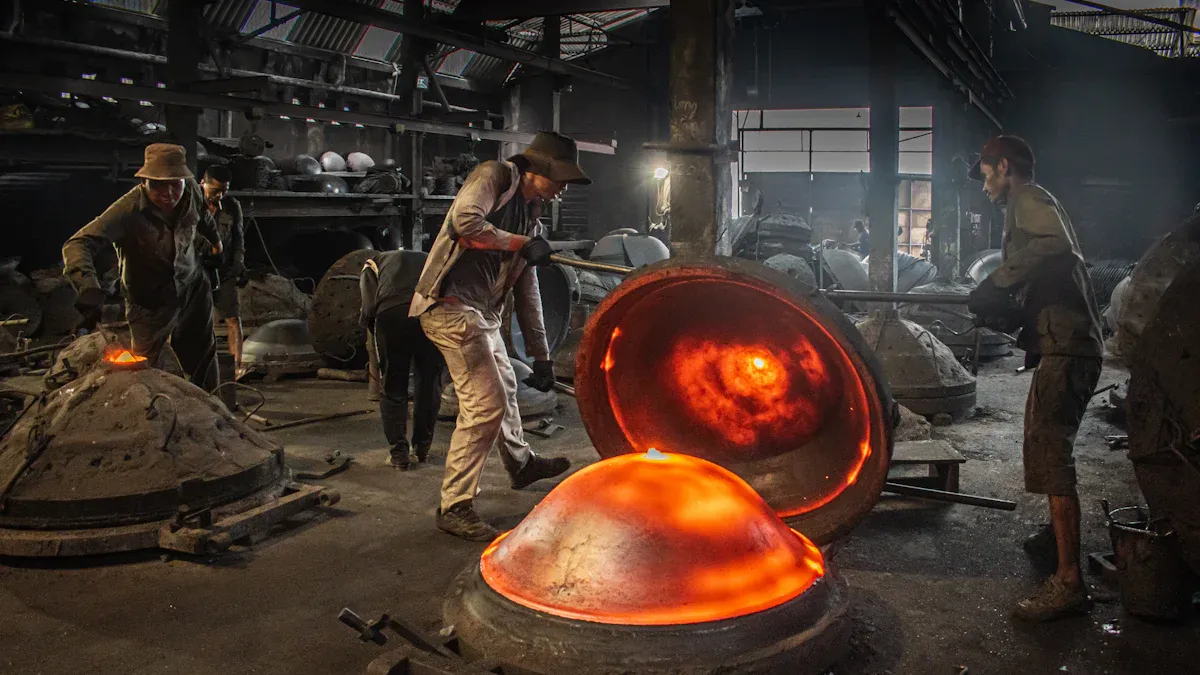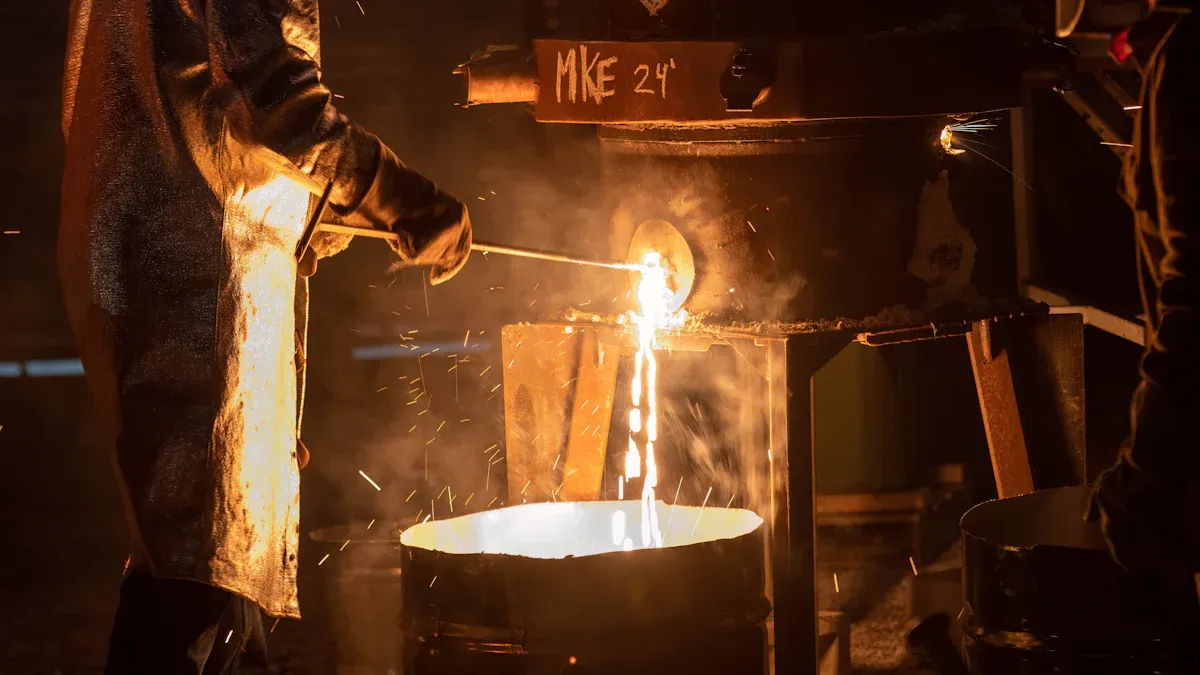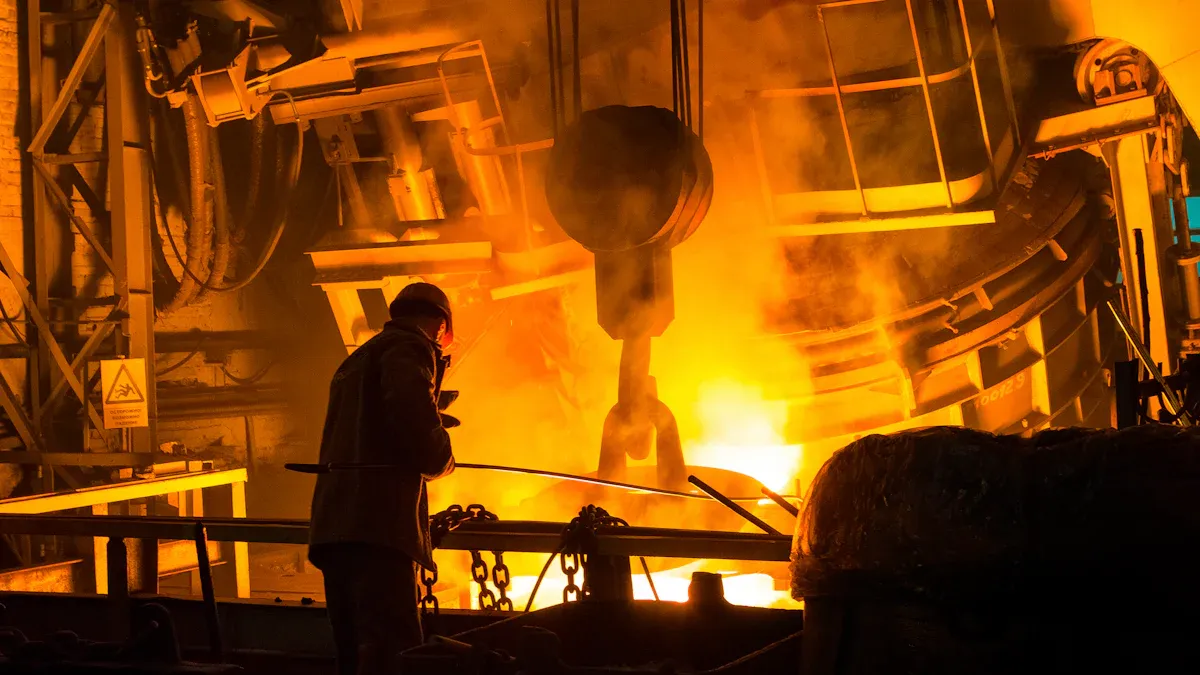
Silicon bronze precision castings combine durability with remarkable precision. This alloy, known for its corrosion resistance and strength, is ideal for creating intricate components. The process, often referred to as silicon bronze precision investment castings, ensures detailed silicon bronze precision investment casting parts with minimal material waste. Manufacturers rely on these castings for applications demanding both performance and aesthetic appeal.
Key Takeaways
- Silicon bronze is a tough and long-lasting metal mix. It resists rust well and is very strong, making it great for precise casting.
- The investment casting method creates detailed shapes with little waste. This ensures top-quality parts for many industries.
- Silicon bronze castings are useful in boats, planes, and buildings. They are both practical and nice to look at.
Why Silicon Bronze is Ideal for Precision Casting
Composition and Key Properties
Silicon bronze stands out as a versatile alloy, thanks to its unique chemical composition and impressive physical properties. This alloy primarily consists of copper, with silicon, manganese, zinc, and iron added in smaller amounts to enhance its performance. Here’s a closer look at its typical chemical makeup:
| Element | Min | Max |
|---|---|---|
| Copper (Cu) | —— | Remainder |
| Silicon (Si) | 0.8% | 2.0% |
| Manganese (Mn) | —— | 0.7% |
| Zinc (Zn) | —— | 1.5% |
| Iron (Fe) | —— | 0.8% |
| Lead (Pb) | —— | 0.05% |
This composition gives silicon bronze its signature properties, such as excellent corrosion resistance, high strength, and remarkable ductility. For instance, its density ranges from 8.53 g/cm³ to 8.75 g/cm³, while its tensile yield strength can vary between 105 MPa and 415 MPa. These characteristics make it ideal for precision casting, where both durability and intricate detailing are essential.
Additionally, silicon bronze boasts a Rockwell hardness of 55 to 95 on the F scale and an elongation at break of around 50%. This combination of strength and flexibility ensures that components made from silicon bronze precision castings can withstand demanding environments without compromising on performance.
Did you know? High-silicon bronze (C65500) is particularly valued in marine applications due to its ability to resist corrosion in saltwater environments. This makes it a popular choice for marine hardware and architectural components.
Advantages Over Other Alloys
When compared to other alloys, silicon bronze offers several distinct advantages that make it a preferred material for precision casting. Here are some of the key benefits:
-
Exceptional Strength and Durability
Silicon bronze exhibits a tensile strength ranging from 490 to 750 MPa and a yield strength between 105 and 415 MPa. This strength allows it to perform reliably under heavy loads and constant use, making it suitable for high-performance industries like aerospace and marine engineering. -
Corrosion Resistance
Unlike many other alloys, silicon bronze resists wear and tear even in harsh environments. It withstands exposure to moisture, chemicals, and saltwater, reducing the risk of degradation over time. This property significantly lowers maintenance costs for components made from silicon bronze precision castings. -
Superior Casting Characteristics
One of the standout features of silicon bronze is its exceptional fluidity during the casting process. This allows manufacturers to create intricate designs with minimal cooling contraction, reducing the likelihood of defects like cracks or warping. The result is a flawless finish that requires little post-casting work. -
Versatility Across Applications
Thanks to its unique combination of strength, corrosion resistance, and formability, silicon bronze is used in a wide range of industries. From decorative architectural elements to critical marine hardware, its versatility is unmatched.
The Manufacturing Process of Silicon Bronze Precision Castings

Investment Casting (Lost-Wax Casting) Overview
Investment casting, also known as lost-wax casting, is a time-tested method for creating intricate metal components. This process involves crafting a wax model of the desired part, coating it with a ceramic shell, and then melting the wax away to leave a hollow mold. Once the mold is ready, molten silicon bronze is poured into it to form the final product.
This technique is highly valued for its ability to produce parts with exceptional detail and minimal material waste. Industries like aerospace, automotive, and healthcare rely on investment casting to manufacture components such as turbine blades, engine parts, and medical implants. A study even highlights how machine learning tools, like convolutional neural networks, are being used to improve defect detection and enhance the reliability of this process. This innovation ensures that manufacturers can achieve both precision and efficiency.
Mold Creation and Wax Patterning
The mold creation process begins with designing a wax pattern that mirrors the final component. These patterns are typically made using advanced techniques like 3D printing or traditional injection molding. The wax model is then coated with a ceramic slurry, which hardens to form a durable mold capable of withstanding high temperatures.
Recent advancements in wax patterning have revolutionized this step. For instance, a 3D thermo-fluidic CFD model now allows manufacturers to predict the resolution and functionality of wax printing systems. This innovation has led to feature sizes that surpass traditional methods, making the process more efficient and cost-effective.
| Evidence Type | Description |
|---|---|
| Deformation Analysis | The deformation of turbine blade wax patterns was analyzed, showing significant differences in wall thickness and cooling effects. |
| Dimensional Inspection | Results indicated that using a cold wax core reduced deformation significantly in thicker parts of the blade. |
| Causal Chain Analysis | A causal chain analysis was constructed to identify problem elements in the wax mold deformation process. |
These advancements ensure that the wax patterns are accurate, durable, and ready for the next stage of the process.
Melting and Pouring the Silicon Bronze
Once the mold is prepared, the silicon bronze alloy is melted and poured into it. This step requires precise control of temperature and composition to ensure the final product meets quality standards. The alloy is typically superheated to about 75°F above the desired pouring temperature, which ranges between 2,000°F and 2,200°F depending on the part’s size.
To maintain the alloy’s integrity, manufacturers add 2-5% more zinc than needed to compensate for oxidation loss. They also deoxidize the melt using phosphor-copper to prevent defects. During pouring, it’s crucial to avoid agitation, as silicon bronze forms a skin that can lead to imperfections if disturbed.
| Procedure/Aspect | Details |
|---|---|
| Zinc Compensation | Add 2 to 5 percent more zinc than desired in the final composition to compensate for oxidation loss. |
| Superheating | Melt should be superheated 75°F above the desired pouring temperature. |
| Deoxidation | Deoxidize with 3 ounces of 15 percent phosphor-copper per 100 pounds of metal. |
| Pouring Temperature Range | Pouring range is between 2,000°F and 2,200°F, depending on section size. |
| Agitation Precautions | Avoid agitation during pouring to prevent defects such as dross and poor castings. |
| Skin Formation | Silicon bronzes form a skin that can lead to defects if agitated during pouring. |
This meticulous approach ensures that silicon bronze precision castings are free from defects and meet the required specifications.
Cooling, Solidification, and Mold Removal
After pouring, the molten silicon bronze begins to cool and solidify within the mold. This stage is critical, as improper cooling can lead to defects like microporosity or shrinkage porosity. To prevent these issues, manufacturers carefully control the cooling rate and temperature gradient.
- Uniform cooling of the mold and alloy can lead to defects such as microporosity and centerline shrinkage porosity.
- Proper control of the mold cooling process helps form a tapered liquid feeding channel, eliminating shrinkage porosity.
- Insulating modules influence solidification conditions, affecting the cooling rate and temperature gradient.
Once the metal has fully solidified, the ceramic mold is removed, revealing the raw casting. This step often involves breaking the mold or using high-pressure water jets to clean off any remaining ceramic material.
Finishing and Quality Assurance
The final stage involves refining the casting to meet the desired specifications. This includes removing any excess material, polishing the surface, and conducting thorough quality checks. Manufacturers use techniques like Statistical Process Control (SPC) and Six Sigma to monitor and improve the production process.
| KPI | Definition |
|---|---|
| Scrap rate | The percentage of materials that must be discarded because they are defective or unusable |
| First pass yield | Percentage of parts that meet inspection the first time without needing rework. |
| Rejection rate | The percentage of products rejected upon inspection due to product defects |
| Overall equipment effectiveness (OEE) | A measure of how well a machine performs compared to its capacity, based on availability, performance and quality rate |
Quality control relies on checks, inspections, testing, and measurements of final products. Companies should apply a quality control check system that monitors each step of the production line to detect defects as soon as they occur.
By the end of this process, silicon bronze precision castings are ready for use in various industries, ensuring both performance and reliability.
Benefits and Applications of Silicon Bronze Precision Castings

Advantages of Using Silicon Bronze in Precision Casting
Silicon bronze offers several advantages that make it a standout material for precision casting. Its high corrosion resistance ensures components last longer, even in harsh environments like saltwater or high humidity. This durability reduces maintenance costs and enhances reliability. The alloy also boasts excellent electrical conductivity, making it ideal for applications requiring consistent performance in electric power systems.
Another key benefit is its impressive tensile strength. Silicon bronze can endure demanding conditions without deforming, making it suitable for industries like aerospace and marine engineering. Precision casting with this alloy achieves a remarkable consistency rate of 96.29%, far surpassing the 81.22% rate of sand mold casting. This consistency ensures manufacturers can produce high-quality components with minimal defects.
Additionally, silicon bronze simplifies the casting process with its self-lubricating properties. These properties lead to smoother surfaces and enhanced durability, reducing the need for extensive post-casting work. Whether it’s for intricate designs or heavy-duty parts, silicon bronze precision castings deliver unmatched performance.
Common Industrial Applications
Silicon bronze precision castings find use across a wide range of industries due to their versatility and reliability. Here are some notable applications:
- Marine Industry: Components like propellers and fittings benefit from silicon bronze’s ability to resist corrosion in saltwater environments.
- Aerospace Industry: High-performance parts, such as turbine blades, leverage the alloy’s strength and self-lubricating properties.
- Architectural Applications: Decorative elements made from silicon bronze combine aesthetic appeal with long-lasting durability.
- Hydraulic and Heavy Equipment: Pump shafts, valve stems, and seats rely on the alloy’s strength and corrosion resistance for optimal performance.
These applications highlight the adaptability of silicon bronze precision castings. Whether it’s for beauty, strength, or durability, this alloy meets the unique demands of various sectors.
Tip: Silicon bronze’s versatility makes it a go-to material for industries that require both functionality and aesthetics. Its ability to perform under stress while maintaining its appearance is unmatched.
Silicon bronze precision castings showcase the perfect blend of advanced manufacturing and material science. Their unique properties make them indispensable for creating durable, high-quality components. By understanding this process, industries can appreciate how these castings contribute to innovation and reliability in modern manufacturing.
FAQ
What makes silicon bronze better than other alloys for casting?
Silicon bronze offers superior corrosion resistance, strength, and fluidity. These qualities make it ideal for intricate designs and durable components in demanding environments like marine or aerospace industries.
Can silicon bronze castings be used for decorative purposes?
Absolutely! Silicon bronze’s smooth finish and golden hue make it perfect for architectural elements, sculptures, and other decorative applications that require both beauty and durability.
How does investment casting ensure precision in silicon bronze components?
Investment casting uses detailed wax patterns and ceramic molds. This process captures intricate designs with minimal defects, ensuring high-quality, precise components for various industrial and decorative applications.
Tip: Always consult with a casting expert to determine if silicon bronze is the right material for your project. Its versatility suits many applications, but expert advice ensures optimal results.
